Abstract
The article discusses one of the most promising areas of information technology development in the modern world – applications with augmented and virtual reality. The main advantages are identified and the existing difficulties of using an application with augmented and virtual reality are noted. Creating applications with augmented reality will allow the company to better promote its products, due to greater user interaction. The advertiser places items in popular user locations (shops, shopping centers, parks, etc.), which allows the advertiser to increase traffic to a particular place, and users, for their activity, get real benefits. Increases in store sales, which are places with in-game items, increase by an average of 10 %. A comparative analysis of statistical data on the number and type of downloads within this group of applications. The main features of the formation of the price segment of applications with augmented and virtual reality in the global market of information technologies are established. The key factors of sustainable development of the application market by augmented and virtual reality are identified. Creating applications with augmented reality will allow the company to initially invest heavily in a mobile product, but receive huge savings in the future, since the application itself will constitute an enterprise’s advertising campaign and present the advertised product or service to the user at a new level.
Keywords: Virtual realityaugmented realityapplication monetizationstatistical analysis
Introduction
Applications with augmented reality are now in great demand among users of mobile devices (Mago, 2017; Nee, Ong, Chryssolouris, & Mourtzis, 2012; Ong & Nee, 2013). According to an analysis of sensor tower analysts studying the popularity of augmented reality apps among iPhone and iPad users, over 13 million augmented reality apps have been downloaded since September 2017.
The download schedule for such applications, from September 2017 to March 2018, is shown in figure
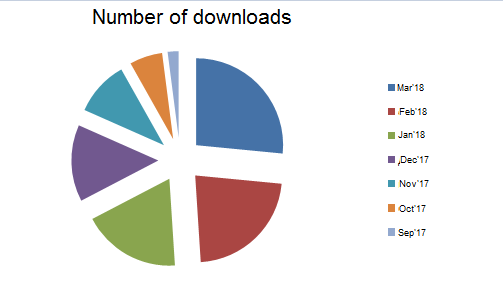
The most popular applications are games (figure
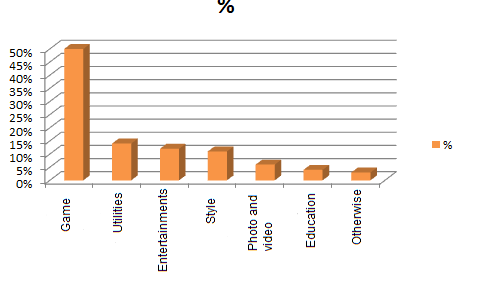
In second place in the download rating are utilities that simplify work or solve certain problems, they have 14 % of downloads. In third place are entertainment programs, they occupy 12 % of the total number of user downloads. The fourth place is occupied by programs that impose various stylistic effects on the surrounding world, such as programs for trying on things, a program from Ikea for choosing furniture and others. They have 11 % downloads. The fifth place was taken by photo and video programs. They were downloaded 6 % of the total number of downloads. Educational programs, of the total, have only 4 %, but this is due to the underdevelopment of this area. On the chart, two are visually displayed downloads.
With Android applications, the situation is different. There are a lot of applications with augmented reality and their number of downloads exceeds 48 million downloads.
An illustrative number of downloads to applications is shown in figure
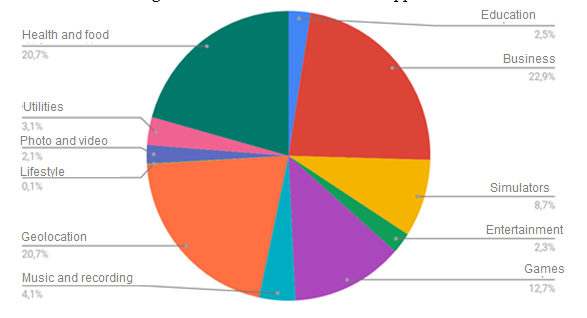
According to data collected in June 2018, applications for work and business (22.9 %), geolocation applications (20.7 %), and applications for monitoring health and food (20.7 %) are most popular.
Augmented reality applications were introduced in the Android environment since November 2012, for the AppStore, Augmented Reality applications began to appear in July 2014. But the augmented reality applications began to gain popularity and publicity only in July 2016, with the advertising and release of the game Pokemon GO (Rauschnabel, Rossmann, & Dieck, 2017). At that time, many developers saw the relevance and interest of users in mobile augmented reality and began the development of technology in this industry.
Problem Statement
The technology for creating applications with augmented reality is not yet well developed and the cost of creating a game project is much more expensive than regular advertising (Klopfer & Sheldon, 2010; Zyda, 2005). But in the long run, the development of such applications will reduce advertising costs and reach a new target audience interested in developing these technologies (Schrier, 2006).
The cost of creating an application with augmented reality requires an initial cost of 160 or more thousand rubles, when contacting the manufacturing companies, with a ready staff, with ready-made solution mock-ups and with round-the-clock support and maintenance of the application. Applications with virtual reality are estimated by developers at 900 and above thousand rubles.
Creating a regular application will cost the customer about 90–500 thousand rubles for a ready-made solution from experienced professionals, so each enterprise considers the relevance and economic rationale for the need for a particular type of application. The life of the application is an average of two years or more, with innovations and additions.
Research Questions
The article discusses one of the most promising areas of information technology development in the modern world – applications with augmented and virtual reality (Carmigniani et al., 2011; Gritsanov & Abushenko, 2003). The main advantages are identified and the existing difficulties of using an application with augmented and virtual reality are noted. A comparative analysis of statistical data on the number and type of downloads within this group of applications.
The main features of the formation of the price segment of applications with augmented and virtual reality in the global market of information technologies are established. The key factors of sustainable development of the application market by augmented and virtual reality are identified.
Purpose of the Study
Creating applications with augmented reality will allow the company to better promote its products, due to greater user interaction. For example, the IZX application allows its users to search for game items and exchange them for real goods or discounts.
The advertiser places items in popular user locations (shops, shopping centers, parks, etc.), which allows the advertiser to increase traffic to a particular place, and users, for their activity, get real benefits. Increases in store sales, which are places with in-game items, increase by an average of 10 %.
Research Methods
The advantages of applications with augmented reality, from the marketing side, can be called the fact that the relevance of such applications only grows and the addition of new places, advertising, goods or services to gaming, development, reference or information projects allows you to increase the return on the project itself, as well as make a profit for account advertising activities. Augmented reality, overlapping on the screen of a mobile device with ordinary reality, will allow the user to receive more information about a product or service than if he had studied it live (Anders, 1999; Hofacker, De Ruyter, Lurie, Manchanda, & Donaldson, 2016).
The cost of advertising on television will cost the enterprise, depending on the TV channel, from 36 thousand rubles in thirty seconds to 2 million per minute. The cost of one minute and thirty second ads on different channels is presented in table
Total cost of advertising time on television has a huge cost and many enterprises will not be suitable because of the high price. But on average, ad views are for company hosted on television (Koller et al., 1997; Ruzavin, 2018).
The cost of advertising on a billboard is from 18 to 22 thousand rubles per month. The cost of advertising on transport is from 2 to 52 thousand rubles, depending on the type of transport and the location of the advertisement. The cost of advertising in mobile applications is from 20 to 300 thousand rubles, depending on the type selected (contextual advertising, banner, mobile sites or applications). Advertising on real media will cost the company less than placing on television or creating its own application, but only in the short term.
Consider the cost of advertising in various areas of placement for a month, a year and two years. For television, we will take a movie size of 30 seconds. The comparison data are given in table
The cost of maintaining the site per month is 7 thousand rubles. The cost of supporting a mobile application is 3–6 thousand rubles (the average figure is 4.5 thousand rubles per month).
The cost of supporting applications with augmented reality is included in the cost of project development (for a period of 1 year). Next year, the cost of support is 10 thousand per month. When finalizing the project and introducing innovations, a new contract is concluded and the cost of supporting the application is included in it. On average, the cost of introducing major innovations costs 40–60 % of the initial cost of the project. For calculations, we take the average value of 50 %.
The cost of supporting applications with virtual reality is carried out according to the same principles as for applications with augmented reality.
Similar growth trends can be observed in virtual reality applications. Last year, VR games and applications from the App Store and Google Play were downloaded globally by 276 % more than in 2016, amounting to 226 million downloads in 2017, according to new data from Sensor Tower (figure
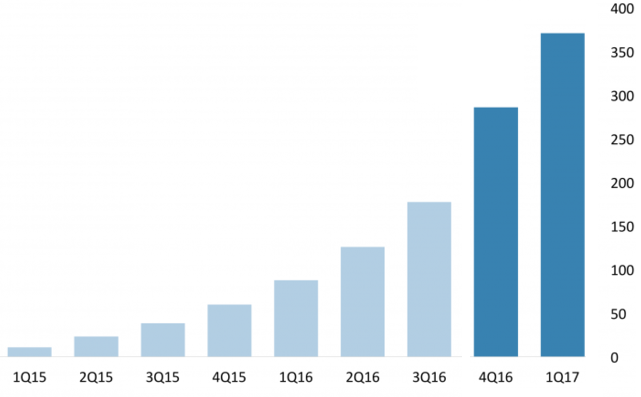
The data show that there is a healthy demand for VR content, despite the poor distribution of special VR headsets.
As with traditional mobile apps, games represent the largest category of VR apps, accounting for 56 % of total downloads. They are followed by entertainment apps with 17 %, as well as photo and video apps with 10 %. It should be noted the large volume of VR applications from the App Store, despite the fact that Apple does not have a special VR headset. App Store downloads grew 727 % in 2016, and Google Play downloads grew 424 % over the year.
The growth of downloads will continue in 2018. This growth will be determined by three main factors:
Greater demand for special VR headsets on smartphones. Although smartphone-based VR headsets exist largely because Samsung combines Gear VR with Galaxy phones, the overall implementation is still in its infancy. However, despite the fact that the supply of VR devices on smartphones grew by 60 % in 2017, reaching 6.4 million units (according to BI Intelligence), further growth of this market is expected in 2018.
More interested VR content developers. As VR headsets begin to spread, VR content developers themselves are likely to begin to see great opportunities and benefits in creating content for the platform. This will help increase consumer interest and trigger demand among consumers.
More advertising from VR content providers such as Google. Consumer awareness is paramount for any new technology, because despite the fact that in 2016 34 % of US consumers did not experience VR technology (according to ClickZ Intelligence), thanks to advertising and the distribution of VR content at the end of 2017, this figure only approaches 5 %.
An important part of the VR application market is the PC platform, on which VR applications are distributed based on Steam's digital distribution service. The significant difference here is that almost the entire VR content market for PCs is mostly expressed by two virtual reality devices – HTC Vive and Oculus Rift CV1.
Based on statistics from the Steam Spy service, in the Steam digital store, 49 % of applications support only HTC Vive, 14 % of applications support only Oculus Rift, the remaining applications support both devices (figure
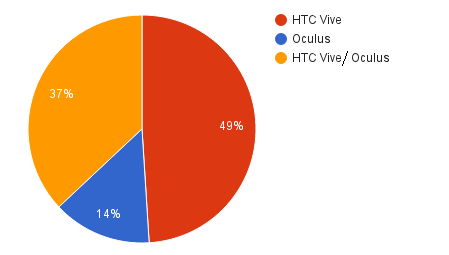
One of the direct conclusions here is that if the consumer has only HTC Vive, then he has access to 86 % of all VR content on Steam, due to games. Consumers who own only the Oculus Rift CV1 device face a 51 % limit on the Steam content library VR.
Another noteworthy factor is that only about 26 % of games on the VR market are in early access (early access allows you to sell access to applications until they are ready). The vast majority, almost 74 %, are full issues. These statistics show that most developers, despite the growing trend in demand for VR content, try not to release raw or unfinished applications for VR devices. Also, based on the collected statistics of Steam applications, you can derive the average price of VR applications for 2017, which doubled from 2016 – from 7.08 to 14.13 US dollars (from 453.12 rubles to 904.32 rubles).
A general analysis of Steam Spy statistics provided in (Papa, 2017) reveals some interesting facts and figures. So, Papa (2017, par. 3) states that “that only a small amount of games have a large number of owners”. Another interesting find of Papa (2017, par. 7, 8) is
“that the majority of sales in the VR market can be attributed to only a small number of games. To put it differently, even though the market has grown, most games don’t sell very well, at all. In statistics, this is also known as a power law, which is a relationship between two quantities such that one is proportional to a fixed power of the other… In the case of this analysis, no matter how large the market of VR games and applications is, the number of titles with a large number of owners will (most likely) always have the same proportion size to the number of titles with a small number owners. An example of this distribution is the Pareto principle (also known as the 80/20 rule), where 20% of the effort results in 80% of the results. Or 20% of the games on the market are responsible for 80% of the total market revenue. In other words: Few dominate the market. In the case of VR supported titles on Steam the Pareto principle holds up pretty well, with 20% of the titles having around 83.5% of the total amount of owners.”
If you take a sample of 1000 projects from Steam, then only 12 items could reach more than 50,000 owners, which is only 1.2 %. Half of the dozen mentioned games are also meant to be played in non-VR mode (e.g. Scanner Sombre, Everspace, Star Trek Bridge Crew, Project Cars 2 and Space Pirates and Zombies 2). So among the almost one thousand VR applications (983 to be precise), just some designed specifically to be used in VR environment. Only seven of them have sales of more than 50,000 copies (figure
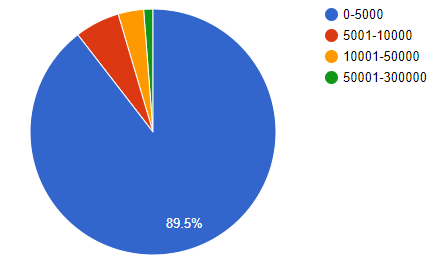
But despite the fact that not such a large part of the entire sample of applications has large sales, those projects that were able to receive wide publicity have a profit from sales comparable to ordinary projects on Steam (without VR support), which is presented in table
It is worth noting that Fallout 4 was already released on Steam and initially did not provide support for VR content. Bethesda Softworks publisher introduced a special version for VR only last year. The original version of the game sold almost 3.5 million copies on a PC and made a profit of more than 210 million US dollars. The profit from the VR version is currently 4.7 million US dollars. Despite a significant slack in sales relative to the version without VR support, this is not a bad result, since the original version currently has almost no sales dynamics, and the release of the same game, but with VR content support, allowed to collect more than 3 million per month US dollar. Thus, large publishers without special development costs (since the work will go with an existing and ready-made game) can revive sales of old projects by releasing their reissues separately for VR, which we can observe based on sales of Fallout 4 VR.
However, the VR Market is only in its initial state (table
Of course, Steam is not the only platform with VR content on the PC market. There are other sites like the Oculus Store, PlayStation Store and Viveport, but the overall picture will be the same everywhere.
Findings
Based on the data obtained, it can be concluded that the creation of a mobile site or application is the most profitable advertising option, since the initial cost of creating a digital object will have the main cost of the project and the further existence of the project will cost a smaller amount.
In the short term, contextual or banner advertising is a more profitable option, suitable for small businesses or for non-large enterprises. In the long term, such advertising will be quite expensive for the company.
Conclusion
Creating applications with augmented reality will allow the company to initially invest heavily in a mobile product, but receive huge savings in the future, since the application itself will constitute an enterprise’s advertising campaign and present the advertised product or service to the user at a new level. Augmented reality allows the user to evaluate a product or service, get the most complete information about it, and also see how a given product or service will look in reality, which will allow a better assessment of the importance and necessity of the goods provided.
With the current market size, so that developers can make enough money to finance their next VR game, the price of applications must go up. Otherwise, there is only one way for development – improving the quality of the applications themselves (which should lead to an increase in demand).
References
- Anders, K. (1999). Marketing and policy considerations for violent video games. Journal of Public Policy & Marketing, 18(2), 270-273.
- Carmigniani, J., Furht, B., Anisetti, M., Ceravolo, P., Damiani, E., & Ivkovic, M. (2011). Augmented reality technologies, systems and applications. Multimedia tools and applications, 51(1), 341-377.
- Gritsanov, A. A., & Abushenko, V. L. (2003). Virtual Reality. Encyclopedia of Sociology, 18, 1312.
- Hofacker, C. F., De Ruyter, K., Lurie, N. H., Manchanda, P., & Donaldson, J. (2016). Gamification and mobile marketing effectiveness. Journal of Interactive Marketing, 34, 25-36.
- Klopfer, E., & Sheldon, J. (2010). Augmenting your own reality: Student authoring of science‐based augmented reality games. New direct. for youth development, 128, 85–94.
- Koller, D., Klinker, G., Rose, E., Breen, D., Whitaker, R., & Tuceryan, M. (1997). Real-time vision-based camera tracking for augmented reality applications. In Proc. of the ACM symp. on Virtual reality software and technology, 87–94.
- Mago, Z. (2017). New trends of marketing communication based on digital games. European Journal of Science and Theology, 13(6), 171–182.
- Nee, A. Y., Ong, S. K., Chryssolouris, G., & Mourtzis, D. (2012). Augmented reality applications in design and manufacturing. CIRP annals, 61(2), 657–679.
- Ong, S. K., & Nee, A. Y. C. (2013). Virtual and augmented reality applications in manufacturing. Spitzberg: Springer Science & Busin. Media.
- Papa, T. (2018). Analysing the VR market based on 2017 Steam data Ganbatte Devblog https://ganbattegame.com/blog/2018/01/14/analysing-the-vr-market-based-on-2017-steam-data/
- Rauschnabel, P. A., Rossmann, A., & Dieck, M. C. (2017). An adoption framework for mobile augmented reality games: The case of Pokémon Go. Comput. in Human Behavior, 76, 276–286.
- Ruzavin, G. I. (2018). Virtuality, The New Philosophical Encyclopedia. Moscow: Instit. of Philos. of the Russ. Acad. of Sci. Publ. House.
- Schrier, K. (2006). Using augmented reality games to teach 21st century skills. ACM SIGGRAPH 2006 Educators program, 15.
- Zyda, M. (2005). From visual simulation to virtual reality to games. Computer, 38(9), 25–32.
Copyright information

This work is licensed under a Creative Commons Attribution-NonCommercial-NoDerivatives 4.0 International License.
About this article
Publication Date
07 December 2020
Article Doi
eBook ISBN
978-1-80296-095-2
Publisher
European Publisher
Volume
96
Print ISBN (optional)
-
Edition Number
1st Edition
Pages
1-833
Subjects
Management, human resources, resource efficiency, investment, infrastructure, research and development
Cite this article as:
Lobkov, K. Y., Eremeev, D. V., Tynchenko, S. V., Gek, D. K., Stepanova, E. V., & Danilchenko, Y. V. (2020). Monetization Of Applications With Augmented And Virtual Reality. In A. S. Nechaev, V. I. Bunkovsky, G. M. Beregova, P. A. Lontsikh, & A. S. Bovkun (Eds.), Trends and Innovations in Economic Studies, Science on Baikal Session, vol 96. European Proceedings of Social and Behavioural Sciences (pp. 786-795). European Publisher. https://doi.org/10.15405/epsbs.2020.12.102

